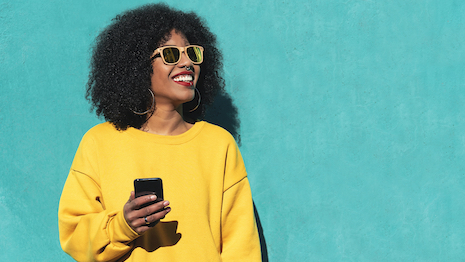Luxury brands’ digital offerings come up short of shoppers’ expectations, at a time when 65 percent of millennial and Generation Z consumers start their buying journeys online.
Forty percent of all luxury consumers begin their shopping journeys at physical stores, but online platforms are increasingly becoming influential, according to a report from ecommerce software company Attraqt. Too often, luxury brands’ Web sites and social media properties are not optimized to best serve consumers as they look to make pricey purchases.
“The luxury shopper journey is rapidly evolving,” said Jon Stephens, director of customer experience at Attraqt, London. “Luxury brands must act now to ensure that they evolve product inspiration and discovery into something a bit less stuffy and much more immersive, personal and frictionless across all channels.”
Attraqt’s findings are based on a survey of 3,000 luxury and lifestyle retail shoppers across the United Kingdom, France and United Arab Emirates.
Enhancing ecommerce
More than half of luxury consumers begin their shopping journeys online, with about a third of U.K. and UAE shoppers favoring mobile devices and 37 percent of French respondents preferring desktops.
About one in three shoppers also use store or brand mobile applications, and 17 percent turn to Instagram as a starting point. However, for 35 percent of consumers, the first time they view a brand’s Instagram feed is through an embedded feature on the company’s Web site.
Younger shoppers use Instagram as a discovery platform
Luxury consumers consider being able to easily find new products essential to quality online shopping experiences.
Among the most useful features on brand sites or apps are product filters, wish lists and personalized product recommendations based on previous searches. Twenty-nine percent of consumers also cited online product reviews as most influential in making a luxury purchase.
Consumers are the least enthusiastic about visual search, product videos and voice-activated search. About a quarter of shoppers, 26 percent, found editorials of trends or collections on brand Web sites to be helpful or engaging.
The biggest frustrations for online shoppers are overly complicated menu and tab hierarchies, followed by limited descriptions and imagery for products. Irrelevant search results or recommendations also hamper the online shopping experience.
As younger luxury consumers are more likely to start their buying journeys online, they are also more discerning about brands’ digital offerings.

Estée Lauder balances retail outreach with ecommerce and a physical presence, supported by visual-rich social media. Image credit: Estée Lauder
For instance, 62 percent of millennial and Gen Z consumers find product filters useful – greater than the general population of luxury shoppers. Seventy percent of consumers in this demographic also consider social media influential, and 48 percent would like social media feeds to be embedded on a brand’s ecommerce site.
“The importance of orchestrating a luxury shopping journey fit for the digital era – connecting the customer with relevant products and creating a series of ‘wow’ experiences to nurture a customer to a sale – has never been more important,” Mr. Stephens said. “In the luxury market this means removing the data silos in their organization to ensure they influence every touchpoint – from the curated editorial content to the search and navigation process right through to the packaging of the delivery and re-engagement.”
Luxury online
High-end and luxury retailers have been experimenting with innovative ways to bridge the gap between in-store and digital experiences.
For instance, ecommerce lifestyle retailer Yoox introduced a feature to its mobile application that uses artificial intelligence to create a more engaging shopping experience.
Yoox, part of Yoox Net-A-Porter Group, launched YooxMirror, which features a collection of products organized around fashion themes on a weekly basis. AI technology suggests specific items so users can create and view stylish outfits before completing a purchase (see story).
Traditional retailers are also partnering with digital experts to enhance their offerings.
British department store Harrods is looking to more seamlessly serve consumers online through a partnership with ecommerce group Farfetch.
As part of the new deal, Harrods will launch a new Web site in 2020 that will be powered by Farfetch Black & White Solutions, the company’s white label offering. With this partnership, Harrods is hoping to more thoroughly translate its level of in-store service to its global digital audience (see story).
“Emotional connections with a brand need to be complemented by a series of logical and seamless discovery to purchase micro-experiences,” Attraqt’s Mr. Stephens said. “Failure to understand unique shopper preferences and behaviors at each of these moments leads to lost sales opportunities, something that will only get worse as the younger buying segment grows.”
{"ct":"IoXwENveuTn3\/Jw7htKQsfv0cDJY60E7ZtqvFlBO7zDpykLGzvCcnkcia+pLnqTJjOd5eZKbuBSHR2oZo\/CgHXZkTL2TsQhTGOh5Dlu4IM0Ky1akRkVPeR3A90Du4rhlQ4YLMr8zjJ9iYI5QMA\/gvYvIl\/zjcXN2A6hKGxWpgI92kDTXW0N2KAFR+eCBUfCl3Se2MPurlEW92o5+NSE\/HpvuMZVErfqcKmgF0CZ\/R3MmFvbIZRjsQvxlRbbXZ6\/X5ogB5hWdp90LFqdBfAWiB9Qt9G98\/tu+watA3Jcw6VRwQ27xk4XDFMEOtefaaqPFTdGPVirYenWCARnl4Nd2Eget\/eAMKo2GdZPGC+uKWCTMHxCx1YL3dm9Tel\/2hlO4jnx0HVvefXMJWTRLys+5JUpwMWBsO004f8e21nLED6Y6X4eaq+QIlPTtV4MspJKaRuH9ZluqKEJJVuEcGS6Jw24+q+dwd62WkSEd5Ex+YVA4k9R5ooX4K2Lf9kCH43QvXuRu9TCvOyPfnofPeP52I2ySMZgB6\/zCj0yrbAkqHLXUmd2NtNukB3fiTrrpQM6QqQu1d2oQN1ljMkUjNg88EyaB1pTf0DBW29x7VxVhWtMufg9\/3JZtenE3hRjFjSu9QV\/fizpqzKZ4rp5lM\/jjHcYZeOHvX2SyuUxio+ttoOkJxNENrkUl3Jaz\/nuZXlZnNHcatyQ3XNwX7Y2moIPps33\/33kBCbh2TD\/syyA054Py3MP4ej6fZDv\/OxS0t6lIPYiVNAnPS1cX4aN+bs7FKRmGdlF0PGbmnaP8\/rY\/0W7SueMmFJzX+UAfqSeT2kDj+mGLx+2epB8hc8XqNziqH486N4ECniHBP9VowR0hSgtGePGK6aqChVc4PgNyeQtvPryUSstv9TdA3Fjm7+rfq6h6RjziNIX+WlW3oUJEesOM1qJp4gVPoyMrSpne6jbRqs9DPveQpTVgNSysooTweyRDkHd6peHb99Gf8OK9fTLP6P7v1SDZV\/RcvVr1rNc\/iTSlQMQA6inLCkNRVb2WPwl6c9jiKB1Y18OvQCxB9f967beQ6W8wMcrm5aDKxVd1a3jQhRTOniXd\/7sYlCmS2sFf9mBbEhfvvLEiifsPfqRGIVKJw5Bhj1Fqk4utTDliKJtyyKwoYSL4r4sX7kGHKjNpk2Wh1RoawJ6M0py6S7xjEwz27ITKc+3YoyMgXeApzV2p2ERorjxGr4hcznQ4nyl2S2Xj8Ly\/F5SjujFjFQrUZWtutrgtOTxtzrGiusDQH9TvhLcF5GHGgtwv9Sy8tBiQehpM6GX3didyB5v6hFJ1N\/q3FjTz2Oo\/6rKel6+7+re7lG2QcQcILah8ulhsbvdwmRVklO12pAkg5rKxuEFXkpcvs5ein0+W0hdn3tjYdNd2kmW1yhCYYmcRZC+0b1U2vGM29ODYL\/N6xPnxff2cmGGjii36Wtwt1AZmzSslNCd7kwn57h+yHZem4UpqCx2me9hBuukjM8RGtlHQoAnstPLHSF0N31ihxnPIyzjHKD\/4IDE5HaMMenEcPI2uBZTTkFc6lhOAXVQXH1vLz3WDCvL0na+8x0Q+JwJWqT5jejD288FmV\/wBgHv2Lw2CqoJoRVQBQ8BKlz09kWCoPbzMsFzT\/EZVmhwCFSqgYl7APEwVcvTfHkXv5ar7vn6VFfoz2G6IiOqbR\/IEkI9OBjiAOJp7Xtty82s33S1Hw1ebP2A+V18Yn4Bnyj011L9T0ss84I0V6dikbs2K7aOGLEiromLeCP0SliHYFson9KxQDxCWiBfhryIBfNT6Eb6jKPWUuMpxfg9FDgU5RwuYYE6ikRm+\/FnpzAfZKMLlHGjj\/IO9Id+ffsXj9Z1T+7AnHZnU9PmCMU7H+BuiDIC9WV8Vo6kwNtTop3qxGMPU0U245Ib44Bzv7q\/05qvoLgH7Z6FWXGqpow6in+U+XfNLr6Kjc1zdOxzQID8NetDfG9RwU4OuGDlbj7+Aux3WgoNC\/koHFS+daZ66l8k0HlreluXcGuZYQCexHw3K3yvPirdEubjTB8eowVYYZARdizP6yApng\/qoYWRMOYme6YFplHFcuhV\/h2vMBOay7mGnbX05hoCKFaiOeTxlZ3LijrI7Sv1ikMBykXjeEwzMbI7V4w3Ku+1o0yrtpkXx8WghAh9paaJ1\/cNx0GaP4lfLKE6kUAIXyF+LPhTnJGt4a4tN9aPhiLa7CMHsl0cJlotJb4VlBGOeQvg6oWEUca8IxGk2YxWb7NI9WjCyJHb7+Bnh+OWhDy2hYGzwmgbu8l+MOmJLSeU\/OKZVA9w7HVbJNACZ3DlKELwezgT7C4JPSWcxiRYAL9hztROBzg6VldeB2QykXOu10D1ZKrQUbNiAXt4sLAwg2aHP7Kucx0yplr9\/k8wfxn23SIcG5wsO9IDP37WviUqB6x9boQlyAjVideN9HLzdnoYBGD4EC0fodiMcXO8QW63UM8oL6U5h3WU9nTz1CYrRT8TeRTRCUvNf6WRHTkCGFvnzYJajJuCKFKujDkcL++BYeOn4VjHZP8GuGFXGyVvzgQQ47TSuImzUq\/q8kSVF8fuaDHt1MqkLZlS64gJbtgogv70QY1LwpfgUyMNX3nwJuR8sdh51qGIee94RbRe60JuxkZrRDC1qi1n55ZRA2WErug7DI75FHYa3QHiKXQ4TCKupuey5ePps7ckFl9v+XmItMMLBsToixUe0Q6z\/ZQYV8TX+V\/OmsKgWT6SW4k0wXVGk7q3SquKOP1b+eVAyYXDPH2DlZMVYkr7Mo7JHeCw6KunWhorbZd5\/UVulbsXABFVpp9KU10h22q8ec8mLaTtHh0MbIS0e5wDdP5ZpoxQwxQv92QRjvZwl7rp84SMzA34v9sM4pYf6Ofuf1zyoq7HS+kb\/tIEx1f7eQfUXIDLAI2E864yeMM9qmK\/2iJHzlIiVCfLjozeLKmMWB5KdqAaj27Ul6j9DikUB9bkGShn\/IFhWVx+1k4P3Aj34s9r+7XMGlWRIA0s4qN81fFS\/mWRA\/fE1LPMZQlrylBqtR53R480sqtVFQptfeJifRnRzvogExlNT\/kKE6SWyltQE1qsrZFQBlMz+Diq4\/kBfaUfTuO59SRjh94VPeZFDP6H1\/ga+4eG0c5Mtm6OtbDCDsMVYjdRXIPu3IgVa4OOfPM8bE5H5DCC5FUH0N4c4s1DeCT8SFy+JAVk6w8Rif7vsOKAI10GXn21yzP4qMO2BgZkwqun77sXZz5nYvQAY5i04qxkErX0Sv\/pufQkmAwweqrTMp0BZrgrSxVRgCo1xloF20vsQq1blsjsPdwbG4et1fH5alKwoLI5xqgttn2wdMKoPSHJz8FOpDVWrzePQBVPJxuVDnQaU73Ec0QW2IzpM10V+0c616p6TEnvEJ7bWqpIsqAv1Ug1aZ7tOUHhlBEMSOCfvSaM7REPT2rBDbKI7DGW\/27B8PGid00P3ZuMGnuGXuYeq8+GH0TLlf\/V44rsf8918WOpjwYVtmtjLwqcbI6teKG2G5HZmmlgr1YPGxkg8NBd1U6DYjwcI3weTSAQgUO\/a3YZU+0XVZIPRiSLr0myoXnYS42xJCbRPeu2IKNma30EVqVklrGikSIbu5AvNuVpO\/ELos2cK\/3V+yUoFRO9TZmlfhabIDNbEjbBj4irSzqnIkeWlXW+52SM4gk9bfE88r7uvSNZDUSXIMTZ6bu2OAIwqapA3rYICgl4J1u7y2BlbcOgCHy56AyTV7IY4\/fVXD6mLOMP1JsQgJhNwnAB1w2\/VGhygF05lVaylidOKO\/utQf5n3VrTVS7mLGZhtua17OLmKCsZkYxybO+2WqjQUyvnxZx6VKG1DBpNrbrm9SE726gGe\/fR4t40J2WEBcX1VjEek\/UXN7VUZOc5pYCkZART1pK43njl+72FYM6+HGgb1TSwNVzXje6j7Q76HbW4oZX8OS98WFjc0mhIUlm2heDyA2po9YKuTE\/3Csfwm3FA0LEFUhJYmgtLfYGXBp6qjdI6pAjQCos5EIEeptABNqM4EgC1nf6WK1mxEcZdFTnY9OQ70+E3IoAnuw7zUmlh85Je3Cu73cGMaB8o3XYfc\/4mSIJ9Oye9Ev\/doPeYuyKFvwMp6TdVL6JtjUEWERMVSg\/A3IWc+v17GYUxYeNVtbhoe1JPcDZrKSSHAotPHmZmI1GWBTF88whG\/Uev2G1Atzu8+GwMiyU2VY6+hfyhTBJEvcQs8xccr7sb5+YLFDJ8Ol+0exPBa27DC+vFDgRy+fmMbYS8LHpb73gKKkPXboRH9H\/p66e3PZOuwD2HZtYTIIAtl8UEGHJ5N+witEzhumlElvN8WL4\/yrqpGv86xxUT1hotDc82V5c6uVYE84V4oilg28lwa1Jk9x6hdZ8lP73jLSTDIFH49w\/fMwh02cUDbXkEPy8\/4f\/GoRp4uHRwtV0Rs0Mo\/vhKg91XAWlQwmtAc75giUDxvx1DT8X2oeUGHL8BP7x2GH8ORPUefhMlp4qMXPVJKbCm5tH6IVPK0P9hSjkJNubYKwK7kj3ZQuEOLcjW738EyKUCJbOCheT2iWxAaJx7UC2gp11MXr46DfiwW\/iv20u5+l\/ZN+SqB1yHCpcyLGEumFZi9hwHUnenz\/j54CZlVv6ejVyW++gyF3ZtaO1nDuZl3ZYce7OaVyqSb56uuyxemdwvnLWyaaY6XQEokzUMEWeKg3u550x1h0VCDp9lJ9rBfuomYvfElcR3qpnUpBh1PIupoHGNzbHXBBstzexcAiToCQpr61A+K2a\/fXAskxiIl0Ednfj0jHVkmfJtQEQihU30F+\/XtKlQuywZoAGEXEz\/EVasXygJxNx8KvURBKvW1NFVEKQUl7hgP0R7PuMAxcLb\/MRQJgyB\/uBdKPnw80PvFeprEZLwQfP4XdgA\/0Xb0pyC0dUl8B9a2GuSNEkOlJK7lZ5ovi\/UFCHNAxizNHT9Y+\/xIWDygtjI6Eef+fGMycZdsbb2QLOd3kyE8kEFkNNNo3mzmOwYCViM9hiiQsNosSWtdEECOe+RswYl0yRBMH2gHJTgfaDiceKveA+GiSB1VD0CrKWM4BgGBBhBdn287UQ6yup1C+QBNIHMDAfF1GD54WZEgsjC3ud8Sluct3HWCv5AKP6+iDAvhCSRo8B9T9Lwq9YI8NNmJ5d6qPomkZHDQIIA9oEJJLxT89XGCS7aPoejiNgAKiPsmd+6rEjiqVnERImqoYDNjlp0vL7OsoY9hj49vOl+v+3s3GugOak9zR9aQKWdmivw8HP6RnvBP6nyQEsrqOzCWVM\/8UuE0+0elM6MsUSv5BxGs6RsP1tBbxEp4hAK2vmj\/YDJh+w0IjYDXemgMofDQIOOJl77T81EuYor7hANyIFSnppM+lpCLHTckePWhFl5qKuwSRb8ha6\/CT+9+wimFmk0wp2bB1CYueDWQy0wHI8qAvElo+tt0\/kWStfaPz16Th78r\/b7JmLPhKRllCCxjbRQZ7TFkUaVTRs7wn6epMWpmhBmSz6fn4hICj\/XWuZAEToWMWF5y1im11iVFBUfb25ctgI8G90OdcynRF3XVndwue0JKDbRxZ8Q8sOhhPw24EE5TQQhjhIT8HzGLw78ESvORR\/lSXiyiNO53Vc4fXSCv0gwnITx+ILT\/BQ6LcWo+MdxEkA0JMr+fR7Rux8UMhM5waBQeFz6B5M1pLMBEq7YNsrfsYVatI2LxGe59rQ884nTdmDNuHt4rUMEt\/zs2Vfce9zqCh38dhZcUg8U+DqIc2G2\/nWxLl794P1qg\/yOIX+Zb\/z1z4GGG1TMKbASjwFwoGElUJCHe3wXqlONKFrl4VTxhS1N0dhbeMwTmt8HR0PB1mkSQnhYRKJqWzkwkCTGLTj1r0WnjxKYJybubBYYo9zqoVWY2rPFz5D85BBLqxt1oooqKHtqSDRnU1vSgz7LEynWkfjaPvsmaB5vnUExZ9ihEXJX5+Q56Y32yZD+LvOha3kZKR2D\/z\/ay4cNVJtdZbbODdyKESGvGanxHvaWF\/5VEz7q74oVK2KFeJf\/M\/Fyvz\/yYAs0WHmIqiqc5Az6k75+VWln\/c+x0tQfCPFudCBYOOfX0xPxKiZI09F3YbdpVDs7TbKqM8agZ5u4P0YTb18ZDyqCoTeUbTgd\/RGhKEOhLQ4T\/47lHUv6R4XZt6cHYE+ToOIxCkE5EvlIPi50GsDDA\/bEOS4RE1MW6CD7u3mRpewuB7\/J1PCceSGqFaOR5HEA99MmDM2V+d8abqA7VQMfepr9XMGn1WHyZS9N3g0yEl6urLn6rybgNpR0gXuBy37ffFvYKal+PFN+HETdbdaFrolvx4gXydSFtnuuziKsed8MxX1TCdJfnkntY6ByM65GBAikNxn9fdImIflXDxzJeUB9CjkEw\/uX2FFVDCDEJupy4Dgi3APVvJo+lSMPMXjKjqO10EdA794lS2VWBQ0JLjOK8ktZDlQG+Q7h5FKovvwionTbqXTLAZN7xMpLpG73EXL4P+tv3ACYVBtVzlkSCZvtrluGXUWsIuiYnu0xIwLbq3YVOkLidnwAp2qJFfL7f9hw0i3wYX41z+lN3iGZaXwb5GxALWb+z9aaGL7n3G1jdOLksBSWj2ywvFBXxig8krbu\/gj\/tanLu+HEqsB7w7RGUdVZUZ5PcYjRXCwe5yx7KkTT6pBYVSk1RE4PcDsvEPcbkGTP2ounYGPt90RUP6YXj1tVAiFqsMrT2XHYWkj++khee0wDUGUpSJPwhrnU0vKd2Eh492H4lHZxMLKH57KFD+yFqvjWsvaSU2EpwUkk5Xv41FzbKcSHlkdt6pQGweo21ddxMYtIvVv6f0wiJ2uSPp5BQurERYgM0U6RND7dtHrAjSevAXiE\/j9jwYJQh\/EiW\/EpVxUPMohDr5eqeWGtFLDV24hJW\/\/J\/UFMbNrEEp2zGmf6irvuqqLn5I6dgQ4UYvld82Dr30Wp8LdcHK45Xa9RKsXqj3j1yFOW2+PSdHiF3\/stbhVrPfuISHBYGAUznOhkIWncz\/en4d\/3lXh371Oimf+bRFAMzbs9C3dkdq6NLQ\/BretIDJhpc39AddkpjLPkn2M\/7GCltTCH0dgipfNtYVTBal6mTov0cYvxvbsjkfLQdVHfmva7c6hGZTdXIUy8RQ9FzhDdz0XtCtdwgvcHtFOZfbvUQGnA859f3Yzt7QOEYMduB2koZsrdBZzVlZECtf2tmS2R7Q1M09CiKd4dp4\/NsVvM8ulSo90E6DkclPd\/JzK8cKKR7qMXRSP1xLlYyG748BzTaQObXS2reXK1z\/Ykj77pMsnVYkdaAnIKipoFNsGGMczx8pecta7Uc\/3Iww6rnY04ivgANXWmsqx7SpXVyN2hiFAMp+EJKWz6EprbmtkInb05BF5EY0eRgt1me6FfjUGl0B0\/GBcGVF8x4qwN\/Aif0FiGV2wcWaQy5rCeA5QSBPtPwbsfUt+roprFjC3JaDJw7GSDkq6V2jqRNLdIw8rmAeKGVQNSOVtAnTvh1RBvJYwMf2PFeCySfvW0Cpjo0xNBBYJIBtq\/bG0D6sSn8zeoRjYlHw85hzQAP83JeFPsjnL9drPv7B1c3lHN7nCuDtQrRyGPlU\/IYKXfMzwVnSmMVEnU6g\/lux3ddRXMg4QEjdHaV+v9rccCQzrw14vlcNapUHE1CAWPJOJJQhtsyidKPSnmwNL9Th4CEhWlxd2+WU64KU1i0yANHkRnDfIHSlUCuxnXO0CL9Bv\/X2NQNt8Nsy35azMWQh5SF1YinFU9pmF0bXeugY6+BIqoQJVlj9INLcxFo\/Iesb0k8+hiylJSjQAf7yeDPHNBPmFHwxrqZJz4vD3BozaA6tg\/BKUJCLeTVJQevtkpdjWpiwhlIVcI2kHJ+bdP3af8YYwL0pirzfKF1UxFzo1TGXlGaJNigx78rhOnKB0k6P1J1gF3bveMI2wJJt2PX568TIkxE+qQmVbPx+ibFJ0iOn0EqJu45k1\/sDFd1vvrG8x8BNxv5vM\/yy27cDrI00oIQoo4\/gGiml+p++jwk0qiWk8k9ybj3bv2oLvd8YMoWgi9O+wOlSgSvTf\/b6dhQ8yg0ov9YxDZVpQIZhuI6c1jmXvOTrhwWPk0Zf6BLmRgy8SqoJWFKqc6lXTzzpQ4p3miQDNAC0ipc9GnPR4aQF8nUXGJN8+Un878QawgHeJN2oja71ZVwhxFPVDGxyxrCO5I0HdyHeeUsOwZ8fftaaYwXOIHGxl\/oave3AK4NYu6CojCYHDfsn\/xXGv\/4lHB62EUwnrZCoZ9YZup6oq\/i3YOVw+v49IpOhqyMZxS4PoeQh+7db75lAMfgaPpm9kPSwx9Z1dYLi5fa+k1f4JNt8neqvuoQf7fczZsXwPYl0UdO2Fkr5q748Ceuc8fYgDZXwNciRnw\/e40rncD3okwIKBKeQ1AqyiFO3D+DrkBIyf\/9hBX3WQqGmN4Toxr2u7B0IxdyaWQ49hSNIT7+wSKWp+dh0hQpzgFdj2akblu7iNZY02fMorttGh425lKDIaN0p7goAR69A1gWb8AA7oOWDANyTIFubp4UpSmPDbxs9oMUpT9p62c5QBt\/BgdG2wTM4CUrUVdk9fS7irmidoD4x\/bcvaVmQoC+k+Ot7J+PlW9a3k9Jt8ln6eDb0B5dcXuxShu2K\/1j0G0hTCDiudjfH2BBwPf\/9FgZWSwNpRxuEMnDbHwROuHU3JfHpoFB\/KJGJ+dQSdO7dpbhcq1v5oT42xhxVqP+GhpBHPLZJ9kELH8B7qkTOxwpXvWyVQbpQK4Fw2LPw1hRg5PP1jzB7aamXP+fzks8xcFxy9OT1T\/w7xszbCw5IkSAyi5OOaaj1tF+GYYHbpsn1ghlZABQ1bpv\/UP1U\/DMTq8\/Gz1q8qv+XWZ3dMJyqdup2jzFE2z6I7OC0B6ZfAodwG67OQGC3ZUbrXt59WQGA5JlsgVmYlVXgyFRje903IGqNe1BEfQhhbwxMHzFK58KtYITL\/o3wezk\/\/BNlQPRLXIAE+f+Gn26LBaclAJrotazDLcWCog0MZ6iXnbwGH65HC3Cy9BkYk5+a+mWb7Vun0iUYjEU7pDQcC9fwYAoU4QxqdF1D8M26E\/mrDADna53apSLek5eF4RuKcFrB2nN16GzP2V\/ZbUh2cj\/MkRSXnhEUtdlrdPLfw3G789qcO3HNg3B6iGNIBKfKWATeAGIJu+hTHQyz\/\/IV60E8qdAgIHyba8lsR7WfdxSY\/aCONNzmXNwUHZniKymg+hAn\/urrcn8svwj7dBhmuRQ5ex5C9gNYqh63U7gyyKdyrAsiYbou+R0Y4Ysfwut3MRWUsJwojTmNF3zYTxPRGFzQFxKsX6BaBZHwrOJxZ3nk8wFkA0PjgHX15e80Dmjsac133QGTHtvza47YLCSU8bWh4dxpXXF1WwyXPe9Ycnzj1SWp3oax2mWv\/vxBTNPGSoR1sg7siFyZngMUPcXsrrdyEbgwsLJX+BLtZ8veMoJJQDsvik0rV6Kabm+QYNJ4NiSQkde4i7jPcUVkk9Ja4hcqoLUWLg0E8NAomre45xeWoDlb49KrjfVR0AUHN3dyNRD5wKOPqUBNYUhfFSgMZkSmRA+VnEfpoB4MNW65+b+jA7\/h1+761wesU6SpoYfTKDhwB9iMEMJbPV7vr2sclh2nRdWj+2Cap8LD5Jwd9K5t+k70pmR0PXWD46fJ3klF8Ysm22WG\/g5kIZsz3QbQBXWbXc6hvr+VkTeTkdOUdN1csglv0fkbt7reXAMCttQbj\/FkBYJZ+8iJ\/eItmj0UJK1KSErPVfd4J2B7MzZaIPuWom2hXSilhfC3wi+uOBjrdVvY6Waa136BGr+3u87OlxDbxVt4KDCh77SIArX8Z+vuURq8ZKDwanhkvcyCzZUijUD1OxVfqv8TaZXdQ8\/RtSlGM4HciVZfXAMKgvNrEbhbqKPhWuug4x7VWffNfCFQ\/hLuBSIJVRZBMIrKA\/i3G093\/NujNcj+VOEFRW\/ZeOBiog5CV3T9Jj1hivXnEvvGH7ORj1hmk8TgbDTVMKCsUWLrY2LjMtKVFLhmKlMg1AmIpzflTpQp5ja\/sI3bRHhYtIXlaUTXoJvHzeMUIOC5fXtJ4luvgyKTyAnErJJZGQNOSc44cupphQRaeSWTn26edl6neMyLQrgcoXJ+nl9YOmjXdg8XyfB7guYpILf59nAXhWZduaWBddwANrdERu6wsHLR87V+p1LFI68CMOn0XKwAITh2onAPjM8x7DMvDAzU\/Zg1AEr5d0LfN6HkMUJfilOgXUmMu2BYuX5gicN2JF0UWYEdr0R3iIr8Jp+2JUmIiDTaZn0nMhdGnPVEArjFx+WjIM+FtOFN+7hzqqbQRF66\/DFi9X\/5iZ3j3vFnXbpaBNGxUHNjSrfSKl29U94gnFdb\/a42ahecEWecNtfSDMOnxn3t9uAEo2RvuCKQEG+OVkE09Us5udgpMem5Pswcl4YgoVKWjmoOUxiGFs+HeTibRJsWLDuy\/K7Bs7nicQyCdy+iNAGgUnklOg4Xpgs3dJaAZRiC3T5spdIW7EZgYR4\/oDUtEeE6ZeJKHRgOEdN0urKKub4KDFdfC+Di40deIAl9ro3j\/To15Tc7C1ag3xe\/+3Fv4r9piK8D7A2f1FdRbAAVpw56Dg50TEBrgFO+pOca5jNq+poPKtaICe+67cFOt3Ph\/Wv8lhjhxlO8ODcvdyF0HTUwOmU2Y6NN9SsThd6aKku2ZlqClYoBbi","iv":"06760ba8c66bcfc913eb2a8e9f3e7c83","s":"ff90932062bb170a"}

 More than half of luxury consumers begin their shopping journeys online. Image credit: Attraqt
More than half of luxury consumers begin their shopping journeys online. Image credit: Attraqt